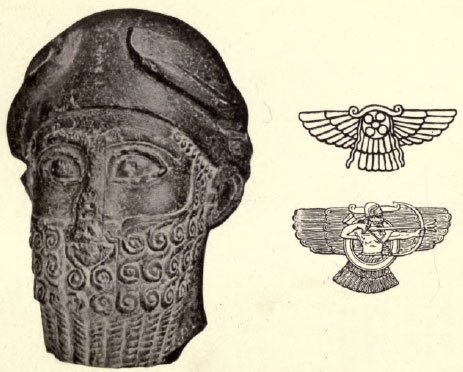The civilization of Babylonia and Assyria
Its remains, language, history, religion, commerce, law, art, and literature
by Morris Jastrow | 1915 | 168,585 words
This work attempts to present a study of the unprecedented civilizations that flourished in the Tigris-Euphrates Valley many thousands of years ago. Spreading northward into present-day Turkey and Iran, the land known by the Greeks as Mesopotamia flourished until just before the Christian era....
Part X
We have several times had occasion to point out the dependence of Assyria upon Babylonia, extending to all aspects of Assyrian civilization, though we must not lose sight of some additions made to Babylonian culture by the northern empire, or of the modifications introduced by Assyria in what she took over from the south. In the case of the pantheon we have only one striking figure, embodying the spirit of Assyria and who represents an entirely original contribution the god Ashur.
We now know that the city bearing the name Ashur on the site of which successful and most thorough excavations have been carried on for the past fifteen years, [1] represents the oldest capital of the northern kingdom, and that in fact from Ashur as a centre Assyria begins to extend her dominion about 2000 B.C., though the settlements in the north by migrations from the south as well as through incursions from the northwest are to be carried back to a much earlier period. The name of the god being dependent upon that of the city, Ashur is thus the god of the city of Ashur.

Fig. 1 (left), Ashur (?), the chief deity of Assyria
Fig. 2 and 3 (right), Winged discs as symbols of the God Ashur
The original solar character follows from the common symbol of the god, a reproduction of the solar disc, frequently with the rays of the sun clearly indicated. [2] He is addressed also in hymns and invocations in terms which betray the original conception, though this trait is naturally overshadowed by the supreme position accorded in Assyria to Ashur, who, taking the place assigned to Marduk in the south, becomes like the latter the creator of everything, the ruler of gods as well as of all mankind. At the dedication of an image of Ashur made at the instance of King Sennacherib (705-681 B.C.), the king addresses his god as follows : [3]
"To Ashur, the king of the totality of the gods, his own creation, father of the gods,
Whose power is unfolded in the deep, king of heaven and earth,
Lord of all gods, controller of the Igigi and Anunnaki, [4]
Creator of the heaven of Anu and of the world below, creator of mankind,
Dwelling in the resplendent heavens, Enlil [5] of the gods, determiner of fates,
Dwelling in E-sharra in Ashur for his lord, Sennacherib, King of Assyria, has made an image of Ashur."
The god who dwells in the heavens is a solar deity like Anu himself was, as we have seen. Naturally, Ashur takes on the traits also of Marduk. The role oi creator is transferred by virtue of national pride from Marduk to Ashur. As the universal creator, Ashur controls the deep .as well as the heavens. He is Anu, Enlil, and Ea thrown into one.
The process towards concentrating all divine attributes in one being is carried to even further lengths in Assyria than in Babylonia, for Marduk is always associated with Ea as the father and with Nabu as the son. Ashur stands entirely alone in his majesty. Representing the spirit of Assyria which was so intensely martial as to make her at one time the greatest military power of the ancient world, Ashur naturally becomes primarily a warrior. The artists of Assyria yield to this influence and spoil the beautiful symbol of the god by placing a warrior with bow and arrow within the solar disc.
Without this addition, the disc might indeed have become a symbol of a spiritualized power, as the swastika and the cross became. For the rulers, more particularly, Ashur is merely the warrior whose standard is carried into the midst of the battle field so as to ensure the presence and aid of the god. "By the might of Ashur" is the standing phrase in the votive and historical inscriptions of Assyrian kings. It is Ashur who mows down the enemies, who burns and pillages cities, who captures the women and children, and who spreads the misery and desolation incident to bloody warfare.
As Ashur reflects the genius and spirit of Assyria, so the god follows the varying fortunes of the country. With the transfer of the capital to Calah and thence to Nineveh, the centre of Ashur 's cult shifts to the political stronghold. Wherever the kings reside, there is Ashur 's seat; and when the king himself leads the military exploits, Ashur follows. Ashur is not bound to a definite centre like his two older rivals. He and Assyria become synonymous terms in a sense which never applied to Marduk.
He becomes the lord or Bel, par excellence, who has nothing to fear from any possible rival. A centralizing tendency arises more pronounced than previous endeavors in this direction, and without disturbing the time-honored traditions that grew up around Nippur, Sippar, Uruk, Cuthah, Eridu and other sites. Nineveh as the capital of Assyria rises to a supremacy equal to the rank acquired by Ashur himself unsurpassed in majesty, without a rival in power and glory.
Footnotes and references:
[1]:
See above, p. 55, seq.
[2]:
See Plate XXXIII, Figs. 2 and 3, and Plate XXXII, above the tree of life.
[3]:
Craig, Assyrian and Babylonian Religious Texts, I, PI. 83.
[4]:
The group designation for the minor order of heavenly and earthly deities.
[5]:
In the sense of "supreme lord".
